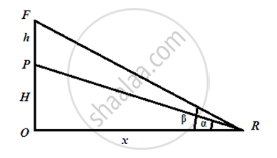Advertisements
Advertisements
Question
A vertical tower stands on a horizontal plane and is surmounted by a vertical flagstaff of height h. At a point on the plane, the angles of elevation of the bottom and the top of the flagstaff are α and β, respectively. Then the height of the tower is ____________.
Options
`("h tan" alpha)/("tan" beta + "tan" alpha)`
`("h tan" alpha)/("tan" beta - "tan" alpha)`
`("h tan" beta)/("tan" beta + "tan" alpha)`
`("h tan" beta)/("tan" beta - "tan" alpha)`
Solution
A vertical tower stands on a horizontal plane and is surmounted by a vertical flagstaff of height h. At a point on the plane, the angles of elevation of the bottom and the top of the flagstaff are α and β, respectively. Then the height of the tower is `underline(("h tan" alpha)/("tan" beta - "tan" alpha))`.
Explanation:
Observe the figure,

`"tan" alpha = "H"/"x"`
`=> "x" = "H"/("tan" alpha)`
Also,
`"tan" beta = ("h + H")/"x"`
`=> "x" = ("h + H")/("tan" beta)`
therefore,
`"H"/("tan" alpha) = ("h + H")/("tan" beta)`
`=> "H tan" beta = "h tan" alpha + "H tan" alpha`
`=> "H tan" beta - "H tan" alpha = "h tan" alpha`
`=> "H" = ("h tan" alpha)/(("tan" beta - "tan" alpha))`
